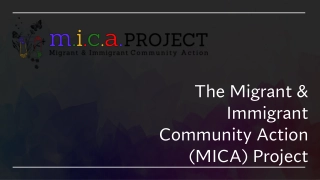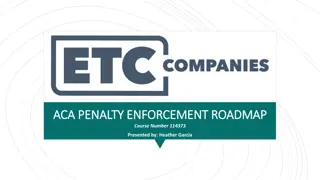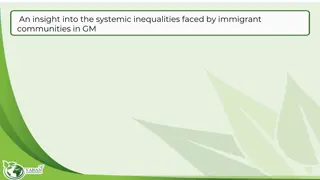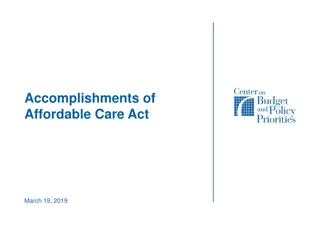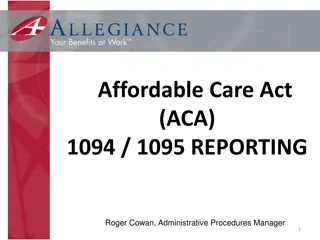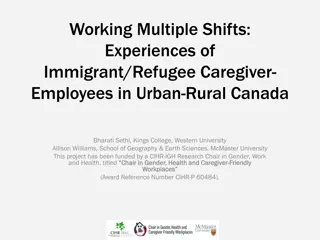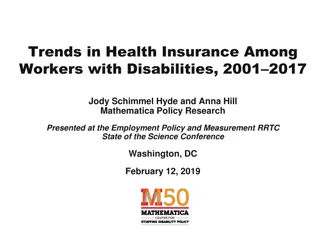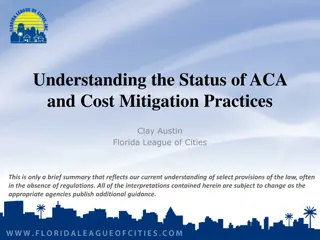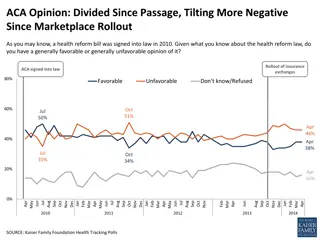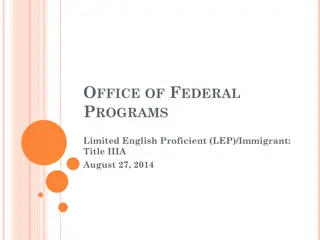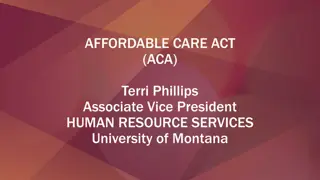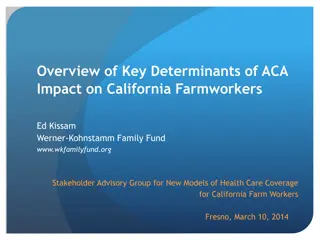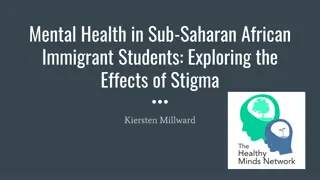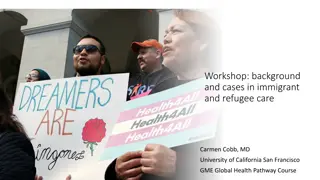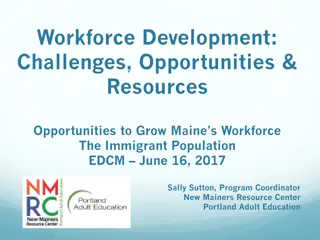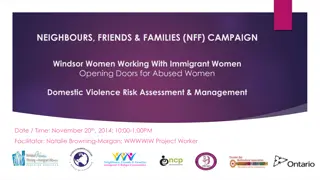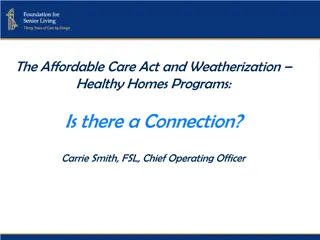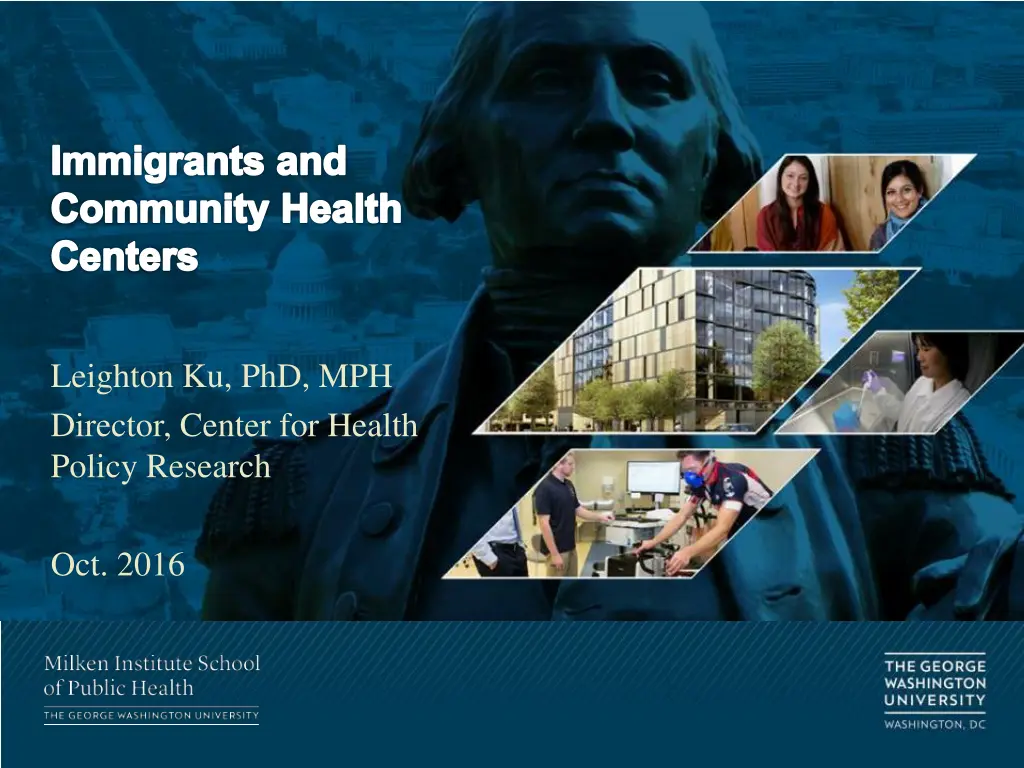
Immigrants and Community Health Centers: Contributions and Controversies
Explore the intersection of immigrants and community health centers, highlighting the contributions immigrants make as patients and staff. Delve into the controversial issues surrounding immigration, including misconceptions and the positive impact immigrants have on America. Discover the journey of immigrants becoming citizens and the potential for immigration reform in the future.
Download Presentation

Please find below an Image/Link to download the presentation.
The content on the website is provided AS IS for your information and personal use only. It may not be sold, licensed, or shared on other websites without obtaining consent from the author. If you encounter any issues during the download, it is possible that the publisher has removed the file from their server.
You are allowed to download the files provided on this website for personal or commercial use, subject to the condition that they are used lawfully. All files are the property of their respective owners.
The content on the website is provided AS IS for your information and personal use only. It may not be sold, licensed, or shared on other websites without obtaining consent from the author.
E N D
Presentation Transcript
Immigrants and Community Health Centers Leighton Ku, PhD, MPH Director, Center for Health Policy Research Oct. 2016
Immigrants and Health Centers Immigrants contribute to CHCs as patients and as staff. Many patients are immigrants. Some CHCs are migrant health centers or focus on care for ethnic groups or immigrants. Immigrant patients serve on CHC boards. Many physicians, nurses, and other staff at CHCs are immigrants (or children of immigrants). CHCs should be trusted providers to immigrants, as well as other disadvantaged clients. CHCs have special obligation to provide quality care, regardless of immigration or insurance status, including appropriate language services and cultural awareness.
Immigration Can Be Controversial A hot button issue this election season. Some try to portray immigrants as: Undermining traditional cultural values. Stealing jobs. Criminals. Terrorists. Not worthy of help. High users of welfare. Xenophobia often mixed with racism & religious bias. Often inflamed as wedge political issue, both in US and other countries.
Immigrants Contribute to America Create jobs, businesses & economic growth. Do not generally reduce employment or wages of citizens. (Nat. Acad Science) Due to low domestic birth rate, immigrants will be majority of future US labor supply growth. Will drive future economy. High labor participation & marital rates. Less likely to commit crimes or be jailed. Recent study found that the risk of being killed by an immigrant terrorist is 1 per 4 million population (mostly due to 9/11). Risk of gun homicide is 100x higher (mostly from citizens). Pay taxes. Contribute to Social Security & Medicare surpluses.
Immigrants as Americans US has always been a nation of immigrants. Newcomers constantly refresh the nation. About 1/8 of all Americans are immigrants. Another 1/8 are 2ndgeneration children of immigrants. 25% of US children have immigrant parents. Mixed families. Assimilation. 1stgeneration immigrants more disadvantaged & poorer than native-born, 2ndgeneration looks like other Americans in income, home ownership, education.
Immigrants Become Us Two-thirds Who Enter as Child Immigrants Become Citizens by the Time They are 30. Naturalized Citizens Not Yet Citizens 66% 34% Source: Ku, 2009. March 2008 Current Population Survey data about citizenship status of those 30 years or older who entered as immigrants before the age of 18.
Will Immigration Reform Occur? Clinton supports a path to citizenship. Trump wants to sanction/deport undocumented and build a wall. Either would be very difficult to pass in Congress without bipartisan support. Earlier bipartisan plans collapsed. Even if something moves forward, major federal expansions of health insurance for unauthorized immigrants unlikely. Too controversial and expensive. Changes at state levels more likely. (California)
Immigrant Health Care Providers About one-quarter of US physicians are immigrants (or foreign-educated) and about one-sixth of US nurses too. Disproportionate share of primary care physicians, internists, family physicians, pediatricians. Essential to care in safety net settings and primary care. Data less available for other staff, but many others whether clinicians or administrative or enabling staff are immigrants. Bring professional skills as well as language and cultural skills to enrich CHCs.
Percent of Medical Residents Who Are Immigrants or Foreign Trained, by Field 42% 34% 23% 21% Internal Medicine Sources: Accreditation Council for Graduate Medical Education, 2014 Family Medicine Pediatrics All Other Specialties
Immigrant Clinicians Often practice in safety net settings. Often use J1 or H1B visas, linked to practice in underserved communities. Must obtain visas and work permits. Even if experienced, typically must have a US medical residency. Face additional licensing barriers or delays because their education and experience is from another country and/or due to language proficiency. Similar issues for nurses and other health professionals. Challenge to help them adapt to new environment and encourage them to remain in safety net settings.
Immigrants A Complex Legal Tapestry ADULTS CHILDREN Citizens: US born with immigrant parents Naturalized citizens Lawfully Present LPRs Refugees & asylees Temporary legal Deferred Action (DACA) Unauthorized Naturalized citizens Lawfully Present Lawful Permanent Residents (LPRs) Refugees & asylees Temporary legal (e.g., visas) Unauthorized (Illegal) Deferred Action (DACA) (DAPA suspended)
Unauthorized & DACA An unauthorized immigrant lacks legal authorization to be in the US at that time. Status can change. Many immigrants enter legally with a visa, but visa expires or they violate terms of entry. Then unauthorized. May get pending status or regain legal status. Deferred Action for Childhood Arrivals (DACA) is an administrative program for temporary legal status of unauthorized children (under 31 in 2012) who have stayed in school and been crime-free. 2 year, may be renewed. DAPA for parents proposed, but blocked in court.
Complicated Insurance Eligibility Status Medicaid/CHIP Exchange/Subsidies Medicare Citizen (including US born children) Yes Yes Yes Lawfully Present Some, not DACA Yes, not DACA Yes Lawful Permanent Resident 5 year wait, except preg women & children (ICHIA) Yes Yes Refugee/Asylee Yes Yes Yes Temporary Legal Immigrant No Mostly Yes, not DACA Mostly No Unauthorized No No No Other Key Rules State, income, age & category Income, other insurance 10 years Soc Sec earnings
Does the Individual Mandate Apply? In 2016, uninsured individuals subject to $695/adult or 2.5% of income federal income tax penalty. Half as high for uninsured children. Mandate applies to citizens and lawfully present immigrants. Mandate does not apply to unauthorized immigrants, but does to legal family members. Exemptions for those with income below federal tax level, those not eligible for Medicaid or exchange, or those whose insurance premiums would cost more than 8% of income.
Application & Verification Healthcare.gov website in English and Spanish. Some info in other languages Medicaid, exchange applications ask legal status. Nonapplicants (e.g., family members) need not report. Applicants should not be asked if they are unauthorized. Asked for Social Security numbers. Don t use ITIN. Verified against DHS SAVE database. If SAVE cannot identify legal status, they need to provide more documentation. If they can t, they may be dropped. These data not used for immigration enforcement. All application information is confidential.
Language Access Under Executive Order 13166 and Civil Rights Act of 1964, health providers must provide free interpretation/translation services to patients who have limited English proficiency. HHS Culturally and Linguistically Appropriate Services (CLAS) Standards (thinkculturalhealth.hhs.gov) Almost all CHCs provide language access, including interpreters, language lines, etc. Relevant not only for clinical staff, but admin staff too.
Outreach Issues for Immigrants Many come to CHCs for care, but are uncertain about enrolling in insurance due to complications and fears. Staff should try to gently encourage insurance enrollment. Don t ask whether unauthorized. CHCs can provide primary care to uninsured unauthorized, but some may be deterred by sliding scale fees. Without insurance, immigrants may have problems specialty or hospital care, or affording medications. Language barriers. Often bring family or friends to help. Multilingual eligibility staff and forms important. Can work with local community groups, schools and foreign language media to help spread word.
Among Low-income, Non-citizen Immigrants Receive Fewer Public Benefits Because immigrants tend to have lower incomes, a large share of non-citizen immigrant families have a member who receives public benefits like Medicaid or SNAP. But, after accounting for income and the fact that most children in immigrant families are citizens, immigrants actually receive fewer benefits than low-income citizens. Immigrants less likely to get medical care, even ER care. As a result, immigrants are more likely to need care from CHCs and to use other charitable services. Immigrants tend to use fewer health services.
Low income Immigrants Adults Less Likely to Use Medicaid, More Likely to be Uninsured, 2011 58.9% 31.3% 29.0% 27.9% 25.6% 19.7% Medicaid Uninsured Native-born Naturalized Non-citizen Source: Ku & Bruen, 2013
Low income Immigrant Children Likely to Use Medicaid or CHIP. More Likely to be Uninsured, 2011 69.7% 65.1% 48.9% 37.7% 16.9% 12.2% Medicaid/CHIP Uninsured Citizen Child w Citizen Parents Citizen Child w Non-citizen Parents Non-citizen Child Source: Ku & Bruen, 2013
Non-citizen Immigrant Adults Less Likely to Have Office-Based Doctor or ER Visit in Last Year 93.8% 83.4% 9.3% 5.2% Any doctor visit Any ER visit Citizen Non-citizen Source: GW analysis of 2012 National Health Interview Survey Both differences are significant p < .001 21
Myth: After Health Reform, Most of the Uninsured Are Illegal Aliens Fact In 2015 73% of uninsured were citizens. 27% were noncitizen immigrants. Unauthorized smaller share (12-15%?) The health care safety net remains essential for both citizens AND noncitizens. Uninsured Noncitizen immigrants Citizens 20.9 mil. (73%) 7.6 mil. (27%) 2015 National Health Interview Survey
Trends for CHC Patients in PA 20% 17% 15% 12% 10% 5% 5% 0% Limited English Latino Asian 2013 2014 2015 Source: Uniform Data System reports, HRSA
Census Data about PA Immigrants Foreign-born rose from 4.1% in 2000 to 6.4% in 2014 51% are naturalized citizens, 49% noncitizens Region of birth: Asia 39%, Latin America 31%, Europe 20%, Africa 7%, North America 2% Speak English less than very well or not at all: naturalized citizens 33%, noncitizens 52% Primary languages among those with limited English: Spanish, Chinese, Vietnamese, Russian, Korean (>10,000) 22% work in education or health care fields 18% below 100% poverty, 21% 100-199% poverty
PA Refugee Resettlement Refugees often have special needs, including language, mental health and medical and social services. Federal govt and local agencies provide transitional help. Resettlement program assists in finding homes, social assistance, employment training, English as 2nd language, etc. Leading regions of resettlement: Central PA (Lancaster area), Philadelphia, Erie and Pittsburgh areas. Leading countries of origin: Syria, Congo, Bhutan, Somalia, Burma, Afghanistan
Special Issues for Immigrants HHS CLAS standards. State legislation? Appropriate language services (bilingual staff, interpreters, language lines) and forms. Enrollment assistance. Medical-legal partnerships for social or immigration issues Linkages with community groups, including refugee resettlement Patient education Special sensitivity about mental health issues

